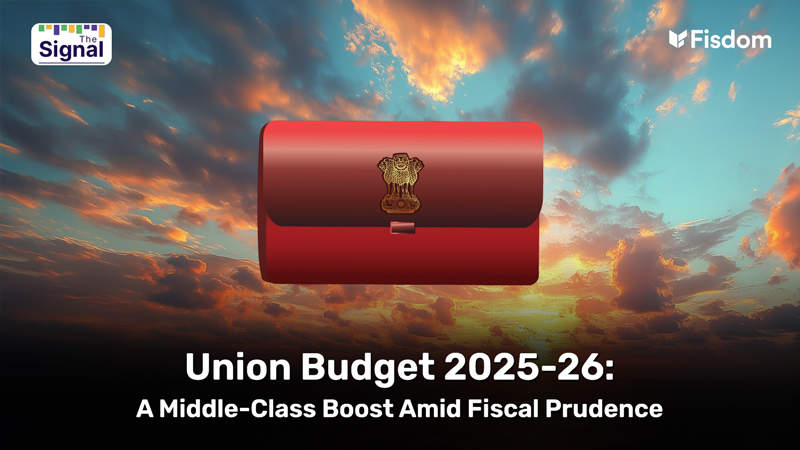
Introduction Finance Minister Nirmala Sitharaman, in her Union Budget 2025-26 speech on February 1, placed a strong emphasis on the salaried middle class, rolling out significant changes in income tax slabs. These measures are aimed at enhancing disposable incomes and stimulating domestic consumption amid global economic uncertainties.
While the budget delivers tax relief to a broad segment of taxpayers, it maintains a cautious stance on fiscal management, setting a disciplined deficit target. The underlying goal is to drive demand-led growth while ensuring macroeconomic stability in an increasingly unpredictable global environment.
Key Income Tax Reforms: Putting More Money in People’s Hands
One of the biggest takeaways from the budget is the restructuring of income tax slabs, designed to leave more money in the hands of consumers. Under the new framework, individuals earning up to ₹12 lakh per year (excluding capital gains) will be exempt from paying taxes. Including the standard deduction benefit of ₹75,000, the effective tax-free income threshold extends to ₹12.75 lakh.
For individuals earning above ₹12 lakh per annum, the revised tax slabs are:
- Income up to ₹4 lakh – No tax
- ₹4 lakh to ₹8 lakh – 5%
- ₹8 lakh to ₹12 lakh – 10%
- ₹12 lakh to ₹16 lakh – 15%
- ₹16 lakh to ₹20 lakh – 20%
- ₹20 lakh to ₹24 lakh – 25%
- Above ₹24 lakh – 30%
These tax cuts are expected to inject approximately ₹1 lakh crore into the economy, potentially boosting household consumption, savings, and investments. The government is banking on this increased disposable income to stimulate demand for goods and services, thereby catalyzing private sector investment and job creation.
Consumption-Driven Growth Strategy
India’s economic momentum has been showing signs of deceleration, with private consumption growth remaining sluggish. During the recent festive season, volume growth in the Fast-Moving Consumer Goods (FMCG) sector was only 3%, with price-led growth hovering around 1-2%. This underwhelming demand scenario has underscored the need for fiscal interventions to revive consumption.
With a substantial sum flowing back into the pockets of taxpayers, immediate market reactions have been evident. Stocks in the FMCG sector, which are highly sensitive to consumer spending trends, saw an uptick post the budget announcement. However, whether this will translate into sustained demand growth remains to be seen.
Fiscal Discipline: A Cautious Approach
In a bid to maintain fiscal credibility, Sitharaman has set an ambitious fiscal deficit target of 4.4% of GDP for 2025-26, improving upon the earlier medium-term goal of 4.5%. This commitment to fiscal prudence is notable, especially in light of increased government expenditure, which is projected to grow 6.9% year-on-year, reaching ₹50.63 lakh crore in 2025-26 from ₹47.16 lakh crore in the revised estimates for 2024-25.
Despite heightened spending, the government aims to keep borrowing in check by enhancing tax revenue collections, projected to rise 11% to ₹28.37 lakh crore in 2025-26. The budget also targets a primary deficit of 0.8% of GDP, a significant improvement from the 1.3% estimated for 2024-25, further reinforcing its commitment to fiscal responsibility.
Reform Expectations: A Conservative Bet?
While the budget delivers direct benefits to the middle class, some stakeholders—especially industry leaders and investors—may find it lacking in bold economic reforms. Many had hoped for structural policy shifts akin to the 1991 liberalization, aimed at unleashing the economy’s full growth potential. However, the government appears to have chosen a safer, more measured approach.
In a global economic environment rife with volatility and uncertainty, this conservatism may be a strategic choice. With capital expenditure (capex) allocation slightly lower than anticipated and fiscal deficit being tightly controlled, the underlying message seems to be: “Let’s hold the line and preserve financial strength for future challenges.”
Stock Market and Industry Sentiments
The immediate response from India Inc. and the stock markets has been subdued. While FMCG stocks reacted positively due to the anticipated rise in disposable income, broader market indices have remained largely flat. This tepid reaction suggests that investors were expecting more ambitious stimulus measures to reinvigorate the economy.
Even within the government, there appears to be some recognition that more proactive policy shifts might be needed. The Chief Economic Advisor, in the Economic Survey preceding the budget, indicated that business-as-usual strategies may not be sufficient to drive India’s long-term economic ambitions. Yet, the budget stops short of aggressive reform-oriented measures.
Conclusion: A Pragmatic Middle Path
The Budget 2025-26 walks a fine line between providing relief to taxpayers and maintaining fiscal discipline. While it effectively positions the middle class at the center of the economic growth strategy, it avoids taking significant risks or making transformative policy shifts.
The key gamble for the government is that higher disposable incomes will drive consumption, which in turn will lead to greater investments and job creation. Whether this bet pays off in a global economic environment filled with uncertainties will become clearer in the months ahead.
For now, the budget delivers just enough to cheer the middle class while leaving the bigger questions on India’s long-term growth strategy for another day.
Market this week
| 27th Jan 2025 (Open) | 01st Feb 2025 (Close) | %Change | |
| Nifty 50 | ₹ 22,940 | ₹ 23,499 | 2.4% |
| Sensex | ₹ 75,700 | ₹ 77,506 | 2.4% |
Source: BSE and NSE
- Nifty showed a sustainable upmove over the last four sessions before encountering high volatility on Budget Day 2025.
- On the special Saturday trading session, Nifty ended 26 points lower amid sharp fluctuations.
- The index opened on a positive note and gained further momentum until 11 AM.
- Volatility surged mid-session following the Finance Minister’s Budget speech.
- Despite intraday swings, Nifty saw an upside recovery towards the close, ending off the day’s low..
Weekly Leaderboard
| NSE Top Gainers | NSE Top Losers | ||||
| Stock | Change (%) | Stock | Change (%) | ||
| Trent | ▲ | 12.73 % | HCL Tech | ▼ | (5.51) % |
| M&M | ▲ | 9.83 % | Wipro | ▼ | (4.78) % |
| Bajaj Auto | ▲ | 8.98 % | Tech Mahindra | ▼ | (4.45) % |
| Hero Motocorp | ▲ | 8.64 % | Sun Pharma | ▼ | (4.39) % |
| Maruti Suzuki | ▲ | 7.93 % | TATA Motors | ▼ | (3.75) % |
Source: BSE
Stocks that made the news this week:
- The real estate sector saw a strong rally after the government announced a major tax relief, exempting income up to ₹12 lakh from taxation. This move is expected to boost homebuyer sentiment and drive demand. Major real estate stocks, including Prestige Estate (+5%), Phoenix Mills (+4.7%), and Macrotech Developers (+3%), recorded gains, pushing the BSE Realty Index up by 1.7%. Additionally, the government’s ₹15,000 crore allocation under SWAMIH Fund 2 to complete stalled projects further strengthened investor confidence in the sector.
- On the other hand, capital goods stocks declined by nearly 2% after the government revised capex for FY25 down to ₹10.18 lakh crore in the Budget. This dampened market sentiment, reflecting concerns over reduced infrastructure spending. However, the finance minister announced a simplification of tariff structures, cutting the number of tariff rates from 15 to 8, which is expected to promote exports. Additionally, the government will launch a State Investment Index in 2025 to rank states on investment-friendliness.
- Agriculture stocks surged as the government unveiled measures to strengthen agri-infrastructure, crop productivity, and farmer credit support. The finance minister announced a six-year mission for self-reliance in pulses, particularly focusing on tur, urad, and masur. Under the Dhan Dhanya Yojana, the government, in partnership with states, will work to enhance productivity, promote crop diversification, and improve post-harvest infrastructure. These initiatives are expected to benefit 1.7 crore farmers, providing both short- and long-term credit support.














